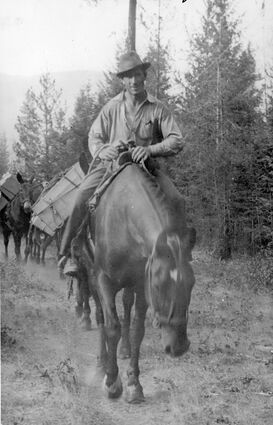Remember When?
August 5, 2021
40 YEARS AGO • AUGUST 6, 1981
MULES STILL PERFORM VITAL WORK FOR FS
By Pat Sullivan
Over the last 70 years the Forest Service has replaced telephone cables with wireless radios, cut back on lookout towers due to the range of fire finding airplanes, and stacked two-handled crosscut saws away in favor of pull-start chainsaws. Foresters have even redesigned the shovel.
But, with all the modern technology and equipment that has altered and expanded the duties of Forest Service personnel, no one has found a complete replacement for the mule.
Mules have been used by the Forest Service since its creation in 1905, and before that when the national forests were only forest preserves. Mule strings of 10 to 12 animals led by a horse-mounted packer were the only means to transport supplies to a variety of work camps and lookout stations throughout the west.
Mule strings were used frequently around Thompson Falls to supply the 12 lookouts in the area, including the 1934 construction of a station on Eddy Peak 20 miles southeast of town.
And last week, with the construction underway of a new lookout tower on Eddy Peak, mules were once again called in to work on the project. Although helicopters hauled up over 20,000 pounds of cement to pour the 14 by 14-foot lookout base, the most practical method to deliver the concrete blocks to be used in the lookout basement was by mule power.
The concrete building blocks, weighing 40 pounds each, were transported up the 6,957-foot mountain by a Forest Service truck to a parking lot 60 yards from the lookout base.
But once the 590 blocks were unloaded from the truck, mules were deemed the only efficient method of moving the bulky structure blocks from the parking lot to the top of the peak. So for two days last week Sissy, June, Jenny and Joy worked in pairs carrying six blocks apiece up the rocky trail. The animals also moved 30 bags of cement to the top of the mountain.
Harold Caswell, chief packer stationed at the Plains Ranger Station, brought the four mules and one horse to Eddy Peak with the help of his assistant, Walt Martin, and fire crew member Tom Rummel, all from Plains.
While Martin and Rummel were loading blocks on the pack saddles of one pair of mules, Caswell was leading the other pair on a round trip atop his horse, Hooter. The original plan was to work the mules in one string, but there was not enough room at the top to turn the four mules around at once.
"The hardest part was getting the mules to turn around," Caswell said, "But once we got the turn-around spot fixed up, it went okay."
Before the mules could be used the crew had to clear the bigger rocks from the Eddy Peak trail. Although their path was far from level, the sure-footed animals had no problems carrying the loads.
The four mules, along with three horses, are stationed at Plains with the Plains and Thompson Falls Ranger districts sharing the animals. The mules are used at least once a week for some type of job.
"They're a pretty unique transport," said District Ranger Tom Squire. "You can use them to pack about anything."
Squire said that in the past, when each district ran strings of 10-12 mules, he saw them carry some unusual loads. He said he saw a large mule with a gas refrigerator strapped to one side and counterweights on the other, bound for a back country work camp. Mules also are used to carry lumber, pack fish for stocking lakes, drag trail graders and plows and carry all the parts used to construct lookouts in the back country.
Good packers can even get mules to carry the panes of window used in lookouts and cartons of eggs for work camps without breaking a single item.
Caswell has packed mules for eight years, while Martin and Rummel are relative newcomers with less than two years working with the animals.
Are the mules ornery?
"You can trust them as far as you can throw them," Martin said with a laugh. "They aren't so dumb."
From their successful adventure on Eddy Peak, Sissy, June, Jenny and Joy proved once again that just because an idea is old, doesn't mean it is obsolete.







Reader Comments(0)